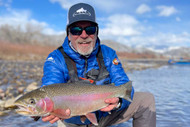Winter Fly Fishing Tips (Here's What You Need To Know)
Fly fishing in the winter can be a challenging but rewarding experience. The cold temperatures and potential for inclement weather can make it difficult to stay comfortable and catch fish, but with the right techniques and equipment, it is possible to have a successful winter fly fishing trip.
Fish With A Buddy
One of the most important things to keep in mind when fly fishing in the winter is safety. One of the best ways to be safe on the water is to not go alone. Try to talk your fishing buddy into joining you for a true winter experience.
Dress in Layers
When you’re fly fishing in winter, it’s important to protect yourself from the elements, and you can do so by dressing in layers. This will allow you to easily adjust to changing weather conditions and stay warm.
A base layer of thermal underwear, a mid-layer of fleece or wool, and an outer layer of a waterproof and breathable material, such as Gore-Tex, will help to keep you dry and warm. A pair of insulated waders or hip boots are also essential for keeping your feet warm and dry.
Use The Right Gear
Another important consideration is the type of fly fishing gear to use in the winter.
A slower action rod is typically better suited for cold weather fishing, as it allows for a more delicate presentation of the fly.
A reel with a good drag system is also important, as it will allow you to easily fight larger fish without overworking your arms or free spooling due to ice build-up in the drag system itself.
When it comes to flies, small nymphs and streamers are often the best options, as they mimic the types of food that fish are likely to be feeding on during the winter months.
Pick The Right Location
When it comes to choosing a location to fish, it's important to keep in mind that fish will tend to be less active in the winter, so it's a good idea to focus on areas where they are likely to be holding.
This can include deep pools, slow-moving sections of the river, and areas with cover such as logs or rocks. It's also a good idea to fish during the warmest parts of the day, when water temperatures are likely to be highest.
Soft water may hold rising trout. Be on the lookout for the telltales of rings on the surface created by those forever sought after rising trout.
When it comes to the actual fishing technique, it's important to keep in mind that fish will be less active in the winter, so a slower, more delicate presentation is typically best.
This can include using a slow, steady retrieve, or simply allowing the fly to drift naturally with the current.
It's also a good idea to fish with a strike indicator, as it will make it easier to detect when a fish takes the fly.
Also, be ready to change your depth throughout the day. Trout move in the water column as temps rise; and sunny days can increase water temps by as much as 10 degrees.
Bottom Line
Fly fishing in the winter can be a challenge. However, with the right techniques and equipment, it's possible to stay comfortable and catch fish even in the coldest weather.
Just remember to dress in layers, use a slower-action rod and reel with good drag, focus on areas where fish are likely to be holding, fish during the warmest parts of the day, and use small nymphs and streamers.
Oh, and don’t forget to bring a buddy. Not only will that make for a safer experience, but you’ll also have a lot more fun!







